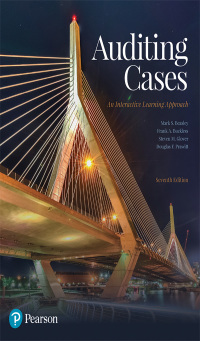Confirmations of accounts receivable play an important role in the accumulation of sufficient, appropriate audit evidence. One
Question:
Confirmations of accounts receivable play an important role in the accumulation of sufficient, appropriate audit evidence. One of the principal strengths of confirmations is that they provide evidence obtained directly from third-parties. Auditing Standards provide guidance to auditors on how and when to use confirmations. Generally Accepted Auditing Standards require accounts receivable (A/R) to be confirmed unless the gross amount of receivables is immaterial or confirmations are deemed to be ineffective given the audit client’s circumstances. While they take various forms, A/R confirmations are typically prepared in the form of a letter from the audit client to its customers. The letter requests a response as to whether or not the customer agrees with the balance on the audit client’s books, as indicated in the letter.1 Although a typical A/R confirmation letter is signed by the audit client, the auditor controls the process by mailing the confirmations to the client’s customers and requesting that the confirmation responses be returned directly to the auditor. It is important that the auditor mail and receive the confirmations to minimize the potential that the client can manipulate the results. If proper control is not maintained throughout the process, bias could be introduced through the interception and alteration of the confirmation requests or responses. When the recipient of a confirmation request fails to respond, the auditor generally follows-up with a second or even a third request. In the event the auditor does not receive a response to repeated requests, alternative procedures such as examining subsequent cash receipts are usually performed to gain evidence about the balance for the non-responding customer.
REQUIRED
[1] List the four factors auditors should consider when evaluating the results of confirmation procedures. Also, what are three of the characteristics of a reliable confirmation? (For this and other questions, you may wish to refer relevant auditing standards).
[2] What does it mean to “maintain control” over the confirmation requests and responses? What could go wrong if the auditor doesn’t maintain control over the confirmation process?
[3] Complete the audit log provided on the next page for each of the seven remaining confirmations. Consider whether each confirmation provides sufficient, appropriate audit evidence, whether sufficient alternative procedures have been performed for non-responses, and whether additional procedures should be performed before concluding that the confirmation provides evidence supporting the client’s account balance. Be as precise and concise as possible.
[4] What is the difference between a positive and a negative confirmation? What are the advantages and disadvantages of each type?
[5] Search the internet to identify a real-life situation where an auditor apparently did not maintain sufficient control over the confirmation process. Briefly describe the situation you found.
PROFESSIONAL JUDGMENT QUESTION
It is recommended that you read the Professional Judgment Introduction found at the beginning of this book prior to responding to the following question.
[6] After completing the confirmations review, your senior asks you to assess the reasonableness of the allowance for bad debts. Think about the anchoring tendency discussed in the Professional Judgment Introduction. How could the anchoring tendency bias your reasonableness assessment? What are some ways that you could mitigate the possible effects of the anchoring tendency in assessing the reasonableness of the allowance?
Step by Step Answer:

Auditing Cases An Interactive Learning Approach
ISBN: 9780134421827
7th Edition
Authors: Mark S Beasley, Frank A. Buckless, Steven M. Glover, Douglas F Prawitt





